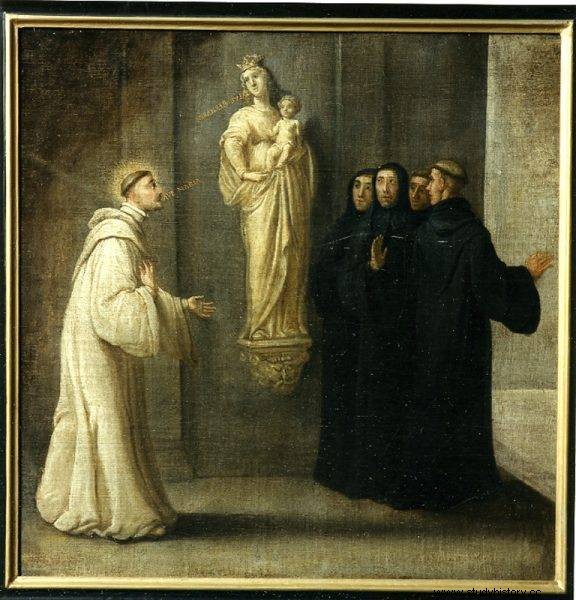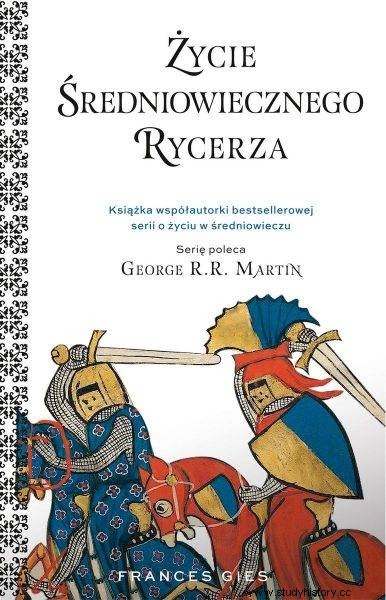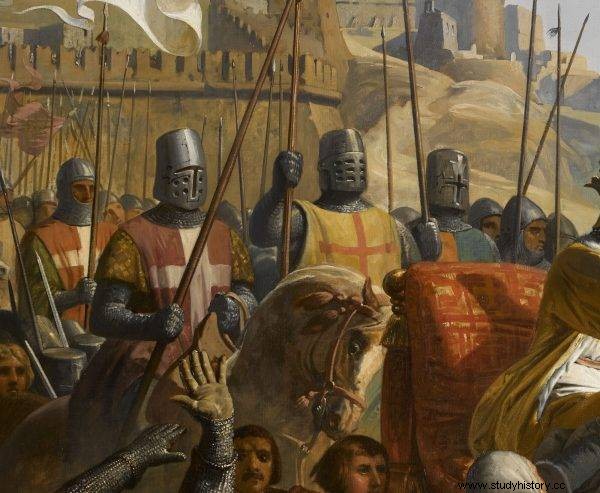"Abominable Templars, (...) and each devoid of zeal and weakness, like vipers, a nest, snakes in multicolored skin, redheads with blue eyes, on their black horses" - wrote Imad al-Din al-Isfahani about them . What were these knights serving God really like with weapons in hand?
After the first crusade, most of the tasks related to maintaining the presence of Christians in the Holy Land fell on the shoulders of members of the knightly orders. In the eyes of the Church, these knights-religious were actual "soldiers of Christ," the embodiment of true chivalry.
The mission of these orders was initially to protect pilgrims visiting shrines in the Holy Land. Soon another duty was added to it, which in time became the main goal of their activities:the creation of garrisons in the conquered areas to fight relentless and numerous enemies.
Iron Rule
The Knights Templar was founded in 1119 by two knights, Hugo de Payens of Champagne and Gottfried de Saint Omer of Artois. These two people made vows of obedience and a life of poverty and celibacy to the Patriarch of Jerusalem, announcing that they would protect and assist the pilgrims.
The organization initially known as the "Order of the Poor Knights of Christ and the Temple of Solomon" won the support of two mighty and mighty crusaders, Count Hugh of Champagne and Fulk V, Count of Anjou, and was officially recognized by the Church in 1128 at the Synod of Troyes commissioned by Bernard of Clairvaux , the founder of the Cistercian order, writing down the Templar rule. After this synod, a group of Templars with the founders of their order set out on a tour of France and England, recruiting volunteers and seeking land grants.

The rule devised by Bernard, modeled on the Cistercian rule, turned out to be exceptionally appropriate for a knightly order.
The rule developed by Bernard, modeled on the rule of the Cistercians, turned out to be exceptionally appropriate for a knightly order. The discipline which distinguished the Templars in marches and battles quickly made them elite troops in all crusader armies .
(...) The Templars did not risk the sin of killing because their enemies were the enemies of Christ; they did not commit "murder but killing heretics." They lived according to strict rules written by Bernard himself; they had no personal belongings, avoided all excess and exaggeration in food and clothing, lived "together in one house, ready to guard the unity of the spirit and the bond of peace."
Apart from avoiding such vain whims as gambling, hunting, chatting, and other worldly entertainment, they did not overly care for their appearance, which so absorbed the other knights; they cut their hair briefly, did not comb their beards, and set out into battle torn and dusty, with faces darkened with tan, to "seek not glory, but victory [...] more humble than sheep and more violent than lions." Being both monks and knights, "they watchfully and faithfully guard [...] the Holy Sepulcher" (...).
God's Bankers
The Knights Templar sought further concessions and privileges - financial, administrative and spiritual - which freed them from the need to pay numerous taxes and finally made them independent of all church authority, except papal authority; in fact, they were not under ecclesiastical jurisdiction, and only the Pope could judge them.
More and more privileges were accompanied by the increasing riches of the order. The individual Templars had nothing, their entire order, however, received all kinds of gifts and bequests in Europe and the Holy Land :land, slave peasants, cattle, mills, wineries, money and other goods. (...) In most cities in England and in continental Europe, Templar commanderies, usually with a church on a district plan, were formed as the centers of the local communities of these knights.

The text is an excerpt from the book by Frances Gies "Życie medieval knight", which has just been released by the Znak Horyzont publishing house.
However, the most important center of this extensive network remained the headquarters in Jerusalem, close to the Golden Gate and the Dome of the Rock. The German pilgrim John of Würzburg, who arrived there around 1165, was impressed by the great stables that could accommodate "more than two thousand horses or five thousand camels" and "the new and wonderful church that was ready when I visited him" - Saint Mary (…).
The Templar organization launched busy transport routes between Europe and the Holy Land, along which gold, silver, textiles, armor and horses were transported to the east, and in the opposite direction were religious brothers, sent on missions to the west, sick or aged knights periodically dismissed from service, officers carrying inspections. The stream of messengers was coming in both directions.
The total number of Templars in the Holy Land has never been large. The information recorded by the chroniclers about thousands of people participating in the battles was usually exaggerated and included servants, vassals, mercenaries and turcopoles, that is, soldiers recruited from local auxiliaries. The number of knights in one battle or another rarely exceeded four hundred. Also in all of Europe there were no more than a few hundred Templars, a maximum of one thousand or two thousand (…).
The monks' fundraising led them to pursue an inappropriate business:banking. They began by borrowing money to pay for pilgrims and crusaders. The first record of a loan from the Knights Templar dates back to 1135; they then gave her to a couple who mortgaged their real estate in Zaragoza, "houses, land, vineyards, gardens, and all that we had" in return for a loan to make a pilgrimage to the Holy Sepulcher. This landed estate was to be returned after the debt was paid, and by that time the Templars had earned their income from the properties in question.
Thus, despite the Church's ban on usury, the order was implicitly charging interest. It was only a decade from these humble beginnings before they made a huge loan to Louis VII for a second crusade. In addition to lending money to clients, the Templars guarded and transported money and valuables (...).
Masters of diplomacy
In Europe, both the Templars and Hospitallers served the kings of France, England, and Germany as advisers, messengers, emissaries, and sometimes as mediators. In the Holy Land, they practiced diplomacy, not only among Christian countries, but also negotiating with Muslim countries, on behalf of others and on their own.
By settling permanently in Asia Minor, the knightly orders were keenly interested in maintaining political balance and stability among powerful Muslim states such as Damascus and Egypt, and did not hesitate to enter into tactical alliances with them. (...) Some Templars and Hospitallers learned the Arabic language, and members of both orders maintained friendly relations with their Arab informants (...).
During the crusade organized by the Saint Louis IX of France, the last great crusade (1248-1252), orders of knights participated in typical roles:as soldiers, diplomats and bankers . Both the Templars and Hospitallers were involved in the important decisions that preceded this crusade. Representatives of these orders were included in the war council, which chose Egypt as the target of an armed expedition (...).

During the crusade organized by the Saint Louis IX of France, the last great crusade (1248-1252), the knightly orders participated in typical roles:as soldiers, diplomats and bankers.
Although Louis IX made an attempt to organize one more crusade in the last year of his life, he did not gain much support in Europe for this expedition. In fact, the era of crusades is over. The remains of knightly orders in the Holy Land fought heroically to the end, their castles fell and the knights-nuns died, and finally in 1291 the Templars and Hospitallers fought the last battle for Akka.
In this decisive battle, the marshals of the Templars and Hospitallers died, and the masters of both orders were mortally wounded. The Grand Master of Hospitallers, dying in Cyprus, wrote to the Prior of the Province of Saint-Gilles "with great sorrow in his heart, with deep sorrow ...". Troubadour Olivier lo Templier (Oliwier the Templar) composed the words of a bitter requiem:
Anger and regret entered my heart
And I can barely dare to stay alive
Because we left the cross we were carrying
In honor of Him crucified.
End of power
In fact, the spirit of 1095 had vanished from Europe, the former fanaticism and idealism had been replaced by a more rational and materialistic attitude. Perhaps the mood of 1291 was less personified by those of the Templars who died sword in hand in burning Acre, and more by a knight, a certain Roger de Elor, who fought bravely until the cause was lost and then he quietly escaped, loading the ship with jewels , silk, temple ornaments and other valuables as they sailed away from the dilapidated harbor under a hail of missiles and escaping the crash with a looted fortune.
Due to the absence of European Christians in the Holy Land, the knightly orders lost their raison d'être, but they continued to exist thanks to their wealth, influence and organization. The most prestigious and prestigious generation of the Knights Templar, who lived after the fall of Akka, was lost due to their wealth, when the King of France, Philip IV the Beautiful, carried out the liquidation of the order in order to take over its financial resources.

Death of the Templars at the stake
The Knights Templar were then accused of various crimes, mainly of heresy, idolatry and sodomy. Many confessions were made under torture, the grand master and several other leading representatives of the order were burned at the stake, and the order itself was liquidated . The Pope, who announced the dissolution of this order, persuaded Philip IV to hand over the confiscated lands of the Templars to hospitals, which was a refreshing boost for the latter. Philip himself greatly benefited from the sale of the seized movable property of the Templars and the cancellation of his own debts incurred in this order (...).
However, the real contribution of the knightly orders to the history of European knighthood was not the result of the events of the declining period of their history, but the attractive model of a Christian warrior, a knight serving God with a weapon in his hand, created by them.
Source:
The text is an excerpt from the book by Frances Gies "The Life of a Medieval Knight", which has just been published by the Znak Horyzont publishing house.
